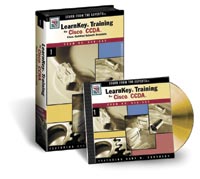|
CISCO -
CCDA
Description
The Cisco Certified Design Associate (CCDA) certification indicates foundation
level knowledge of design for small office/home office networks. In the
Cisco CCDA training course from LearnKey, expert instructor Michael Storm
takes you through exam topics including assessing client needs, designing
a network structure, addressing internetworking issues, LAN and WAN technologies,
and network management. At the conclusion of this course, you’ll be
prepared to pass the Designing Cisco Networks exam 640-441. Updated to cover
640-861 DESGN
|
 |
Course
Outline
Module 1
Section A: Introduction Overview CCDA™ Scope Series Prerequisites Objectives
CCDA™ Skills
Section B: Design Goals Overview Business Requirements Technical Requirements
Application Requirements Network Management Security Requirements Business &
Political Constraints
Section C: Design Framework Small to Medium Networks Design Process Access Current
Network Physical Assessment Logical Assessment Traffic Assessment Management
Assessment
Section D: Network Design Application Considerations LAN/WAN Design Bandwidth
Planning WAN Devices Protocols Design Document & Network Management Design
Testing
Section E: Assessing the Network Data Collection Corporate Information Assess
Staffing Needs Technical Information Performance & Applications Network
Management Assess Security
Section F: Documenting the Network Documentation Steps Customer's Applications
Network Protocols Current Network Network Topology Addressing Schemes Potential
Bottlenecks Analysis Tools Business Constraints Network Availability Network
Performance & Reliability Network Utilization Router Status & Management
Tools
Module 2
Section A: Network Health Overview Health Checklist Transmission Errors
Section B: Extracting Requirements Overview Business Constraints Security Requirements
Manageability & Applications Performance Requirements Identify Customer
Needs
Section C: Characterize Traffic Overview Broadcast & Multicast Flat Network
Scalability Frame Size Windowing & Flow Control UDP Error Recovery Traffic
Loads & Behavior
Section D: Application Considerations Source-Route Bridged Routing Information
SRB with Routers APPN Data-Link Switching Microsoft Networking DHCP IP Helper
Address WINS
Section E: Multimedia Networking Overview Packet Voice VoIP Video Streams
Section F: Networking Services Novell Application Services Reduce SAP Broadcast
AppleTalk Services Firewall Services PIX™ Firewall Mail Applications Future
Application Plan Characterize Applications
Section G: LAN Design Topology Hierarchical Model Cisco® Hierarchical Core
Layers Distribution Layer Access Layer Hierarchical Examples
Module 3
Section A: Redundant Models Overview Workstation to Router HSRP Server Redundancy
RAID 5 & Clustering Load-balancing Minimize Downtime Mesh Models Media Redundancy
Spanning Tree Algorithm WAN Redundancy MPPP
Section B: Secure Models Firewalls Three-part System Firewall Rules Cisco®
PIX™ Firewall PIX™ Features
Section C: LAN Types Overview Large Building LAN Campus LANs Small & Remote
Office LANs
Section D: LAN Media Ethernet Design Rules 10Mb Fiber 100 Mb Fast Ethernet 100
BaseT Repeater PDV Calculation PDV Steps Token Ring Gigabit Ethernet FDDI
Section E: LAN Hardware Overview Repeaters Hubs & Concentrators Bridges
& STP Switches Routers Routing Protocols Combine Routers, Switches &
Hubs Section F: Cisco® LAN Equipment Overview FastHub™ 400 Catalyst™
1900 & 2820 Catalyst™ 2900 Catalyst™ 3000 Catalyst™ 3900
Catalyst™ 3500 Catalyst™ 4000 Catalyst™ 5000
Module 4
Section A: WAN Design Requirements Design Considerations WAN Enterprise Access
WAN Design Steps Design Criteria Star Topology Fully Meshed Topology Partially
Meshed Topology Minimize Bandwidth Cost Optimize Bandwidth Quality of Service
Section B: Selecting WAN Technologies Analog Modems DSL Cable Modem Leased Line
ISDN Frame Relay ATM Cost Considerations Frame Relay Considerations Other Cost
Considerations WAN Connection Types Split Horizon
Section C: Selecting WAN Hardware Cost Criteria Functionality Criteria Redundancy
Criteria Cisco® Router Solutions Switching Methods Router Performance Design
Theoretical 10Mb Ethernet Performance Traffic Calculations Other Considerations
Router Performance Rules Media Mismatch
Section D: Provisioning the WAN Overview Signaling Standards Frame Relay Choosing
CIR CIR & Discard Eligible Determine Core Bandwidth Determine Link Speed
& Interfaces Choose Router Platform Traffic Shaping
Section E: IP Addressing Device Naming Logical IP Addressing Reserved Private
Addresses APIPA Subnets IP Subnet Examples IP Address Rules Subnet Mask
Module 5
Section A: Advanced IP Addressing Supernetting Route Summarization Calculate
Summarization VLSM Plan VLSM CIDR
Section B: IP Routing Static vs. Dynamic Distance Vector Protocols Link-state
Routing Link-state Protocols RIP Version 1 Routing Loops Prevent Loops RIP Version
2 IGRP OSPF Common LSA Types OSPF Areas Area Types OSPF Router Types
Section C: Protocols & Routing EIGRP IS-IS BGP4 Administrative Distances
IPX Addressing IPX SAP AppleTalk AppleTalk Routing AURP Protocol Traffic Section
D: Cisco® IOS™ Features Access Lists Encryption & Proxy Services
Compression & Queuing Services
Section E: Design Document Overview Executive Summary & Design Requirements
Design Solution & Summary Appendices & Cost
Section F: Network Management Overview Processes SNMP MIB SNMP Version 1 SNMP
Version 2 Management Products Section G: Proving the Design Pilot vs. Prototype
Prototype Design Design Topology & Prepare Test Pilot Design Prove Design
Protocol Analyzers Demonstrate Findings
Price £ 1475 (Bundle of 5)
Complementary Courses
CCNA
CCDA
CCNP
CCSP
BSCN
<<Back
<<Contact Us
|

